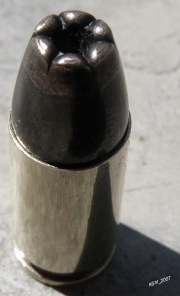Black Talon
Contents |
[edit] Overview
The Black Talon bullet is a jacketed hollow-point bullet with perforations designed to expand sharp edges upon impact.[1] The bullet included a Lubalox (a proprietary oxide process [2]) coating, (though widely misreported to be Teflon, molybdenum disulfide, or wax) giving it an unusual black appearance compared to copper-jacketed or lead bullets. The Lubalox coating was to protect the barrel rifling, and did not give the bullet armor-piercing capabilities. This coating in fact is still widely used on many of Winchester's rifle bullets today.[3] The bullet also had a unique appearance with a star shaped perforation on the black tip, giving it the nickname Starpoint.
The bullet was designed in 1991 under the supervision of Alan Corzine, who at that time was VP of research and development for Winchester.[4] The round became well known amongst shooters, law enforcement, and dealers as a very effective bullet. Col Leonard J. Supenski of the Baltimore County police department said "It has the stopping power that police officers need and it is less likely to ricochet or go through the bad guy."[1]
[edit] Controversy
The ammunition was promptly targeted for vilification by those opposed to the civilian ownership of handguns,[5] and the reputation was very different in the public,[6]and eventually the Talons became to be known by the moniker "Cop-Killer" bullets.[7] The hype of the Black Talon ammunition was the black coating on the bullets themselves. There were wild rumors that the bullets were armor piercing and could penetrate the Kevlar vests worn by Police Officers.[8][9]. The claims are quite bizarre when you think about it, since defensive rounds which expand have notoriously lousy penetration by their very nature, while even practice rounds will penetrate further but have decreased stopping power — penetration and expansion are opposites and designs have to trade one for the other.
Still, facts and common sense notwithstanding, nearly 20 years later, you still can't swing a dead cat without hitting someone who believes in the fairy tale of teflon coated armor piercing bullets.
To further the controversy, some medical personnel claimed that the sharp barb like tips could potentially cause tears in the surgical gloves and hands of the medical workers, exposing them to greater risk of infection, [1] however there were, and still are, no documented reports of this actually happening.[10]
In 1996 a lawsuit was filed after the ammunition was used by the gunman of the 1993 Long Island Railroad mass murder(McCarthy v. Sturm, Ruger and Co., Inc., 916 F.Supp. 366 (S.D.N.Y., 1996) claiming that Olin Corp should be liable for a shooting spree based on the design, manufacture, marketing, and sale of Black Talon ammunition (kind of like how Ford should be liable for speeding and drunk driving). The claims against Olin were dismissed because it was held that the bullets were not defectively designed.[11]
Winchester bowed to pressure and in 1993 removed the ammunition from public sale for a time,[12] and eventually law enforcement also bowed to the pressure.
But at no time was it, nor is it presently, illegal to possess the Black Talon ammunition.
[edit] Current status
Winchester voluntarily pulled the ammunition from the market completely in 2000. The "Ranger SXT" ammunition sold today by Winchester is essentially the same ammunition without the black Lubalox coating on the bullet. Among shooters, the running joke is that SXT stands for "Same eXact Thing." The correct phrase is “Supreme eXpansion Technology”. It is often called a "Meat Cutter" this name possibly could refer to the jacket barbs digging into the flesh (like a fish hook barb) when surgeons try to remove the projectile.
However, there are significant differences in the anatomy of the bullets which becomes apparent when carefully examined side by side. The internal structure of the Black Talon’s hollow point is unique in that its petals are more massive at their tips, after expansion, than comparable bullets. This added mass provides superior expansion compared to most other hollow points including the “Ranger SXT”. This difference is obvious after firing into ballistic gelatin.[13] Winchester has since updated their Ranger SXT line and renamed it Ranger T-Series.
[edit] See also
[edit] References
- ↑ 1.0 1.1 1.2 A Tax Debate Focuses on Destruction Science by Ronald Smothers, The New York Times, November 7, 1993
- ↑ [1] WINCHESTER LUBALOX COATED BULLETS FACT SHEET & FAQs
- ↑ "Biting the Bullets", Op/ED in The Washington Post, January 14, 1995
- ↑ Hex Bullet Hi-Jinx: Taurus' capable copper bullet by Charles E. Petty, American Handgunner, March 10, 2003
- ↑ High-Tech Death From Winchester The New York Times, November 13, 1993
- ↑ ""These are bullets that are strictly used to maim and kill", IN PERSON;On the Other Side of the Divide, by Debbie Galant, New York Times, March 17, 1996
- ↑ "Cleverness - and luck", Evan Thomas and Russell Watson, Newsweek, May 1, 1995
- ↑ "CRITICS TAKE AIM AT BULLETS THAT RIP FLESH, PIERCE ARMOR" by Robert Dvorchak, Associated Press, in Lexington Herald Leader, December 27, 1994
- ↑ "The Value of Banning Bullets" Op/Ed, Washington Post, January 5, 1994
- ↑ "no injuries have been reported to medical professionals removing the bullets" in "Police use new brand of bullets Surgeon says removal may endanger doctors" by Dan R. Barber, The Dallas Morning News, July 6, 1993
- ↑ McCarthy v. Sturm, Ruger and Co., Inc., 916 F.Supp. 366 (S.D.N.Y., 1996)
- ↑ "Winchester to Limit Sales of Controversial Bullet", by Pierre Thomas, The Washington Post, November 23, 1993
- ↑ "Supreme Expansion Technology"
